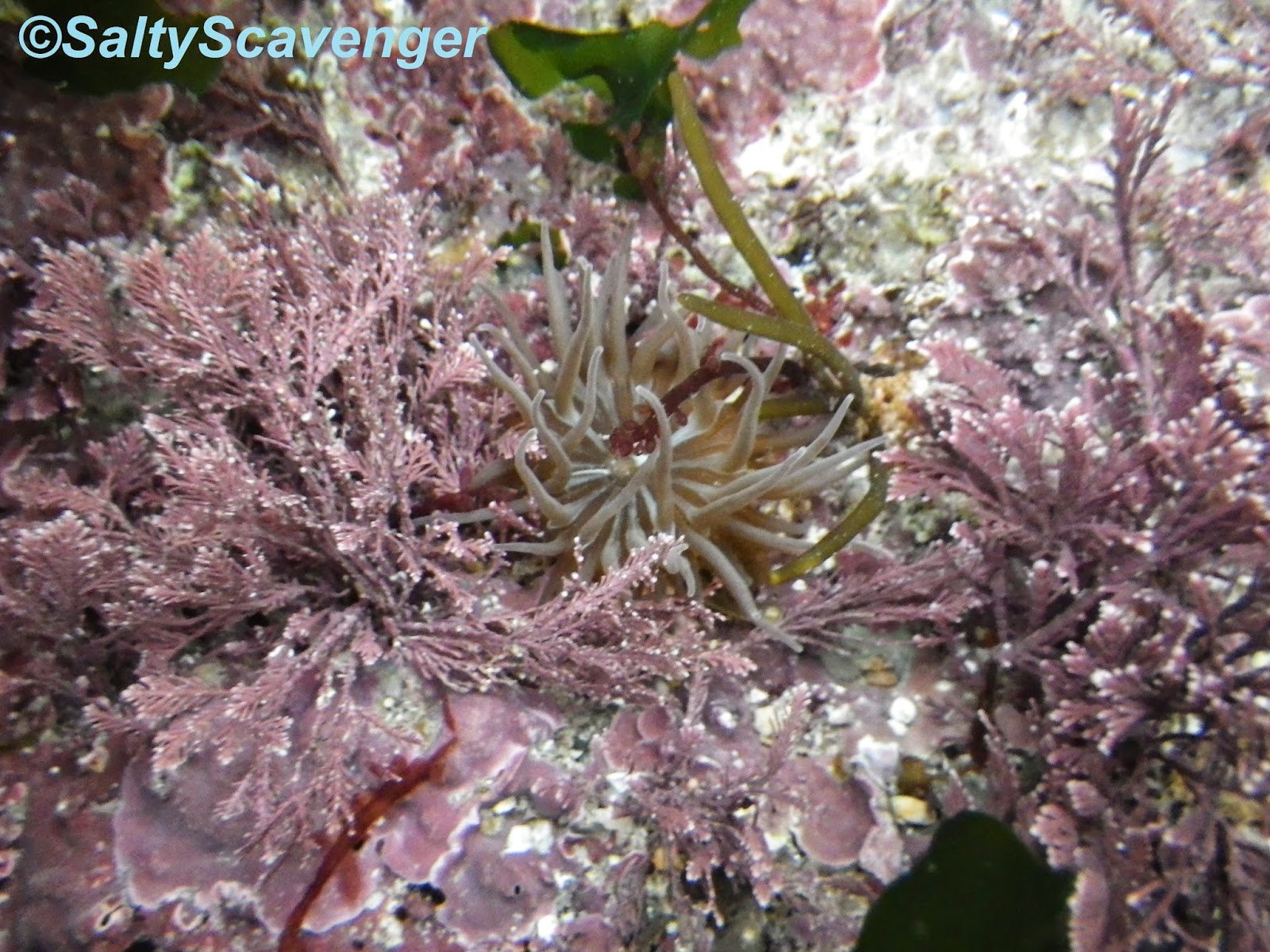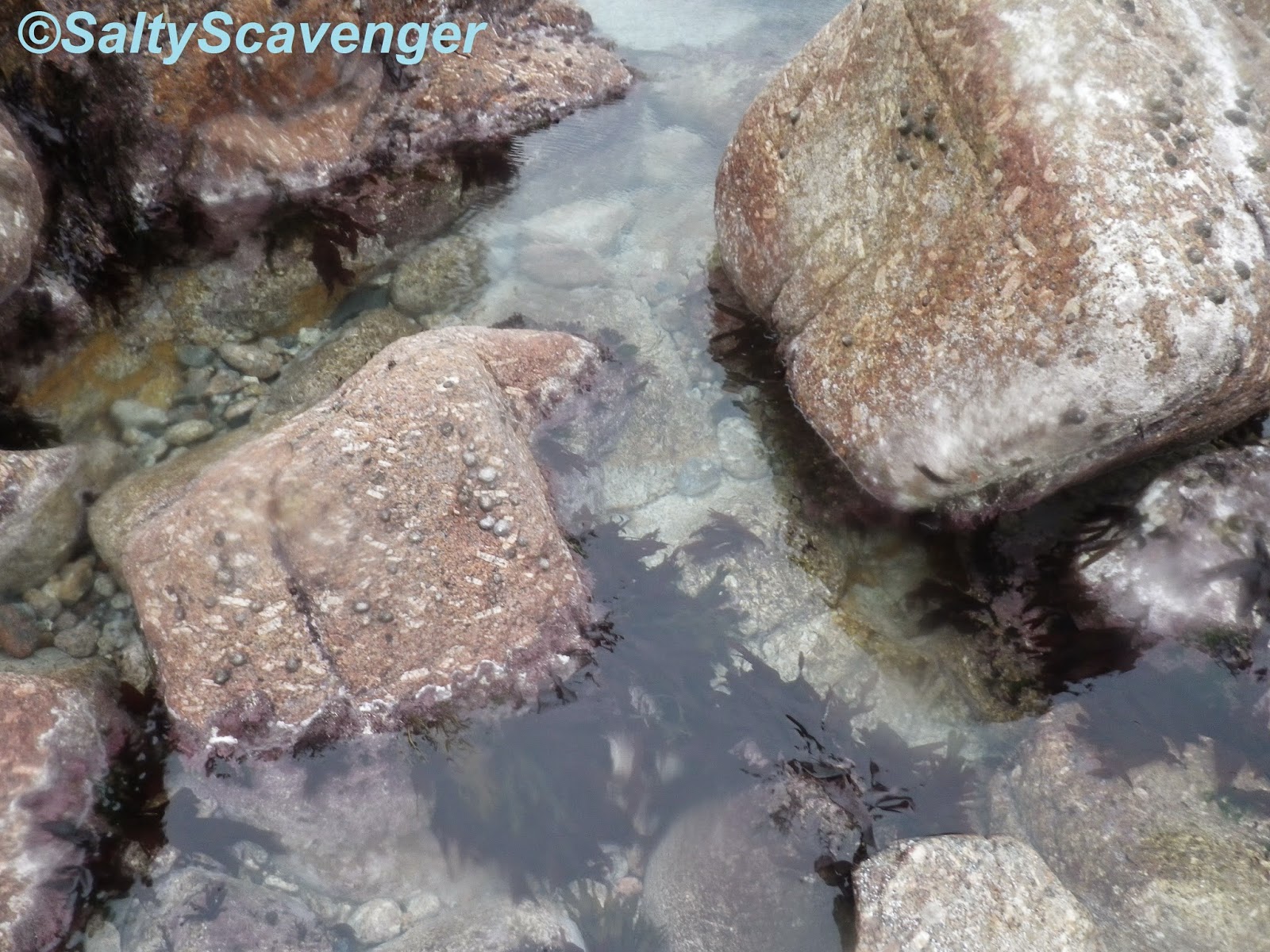The rocky shore is a high energy environment comprised of boulders and bedrock with rock pools, crevices and gullies.
The barnacle communities that dominate from the upper to lower shore are inter dispersed by shallow coralline rockpools in the mid shore, and deeper cobble filled rockpools on the lower shore.
The barnacle communities that dominate from the upper to lower shore are inter dispersed by shallow coralline rockpools in the mid shore, and deeper cobble filled rockpools on the lower shore.
Habitat classification:
Substrate
|
LR (Littoral rock)
| |||
Habitat
| LR.HLR (High energy littoral rock) |
LR.FLR (Features of littoral rock)
| ||
Biotope complex
| LR.HLR. MusB (Mussel and/or barnacle communities) |
LR.FLR.Lic.(Lichens on supralittoral and littoral fringe rock).
|
LR.FLR.Rkp (Rockpools)
| |
Biotope
|
LR.FLR.Lic.Ver (Verrucaria Maura on littoral fringe rock)
| LR.FLR.Lic.YG (Yellow and grey lichens on supralittoral rock) |
LR.FLR.Rkp.Cor (Coralline crust dominated shallow eulittoral rockpools)
| |
SubBiotope
|
LR.FLR.Liv.VerB (Verrucaria maura and sparse barnacles on exposed littoral fringe rock)
| LR.FLR.Rkp.Cor.Bif (Bifurcaria bifurcata in shallow eulittoral rockpools) | ||
Below are images of the organisms you may encounter in the rockpools:
The rockpools on this high energy shore are characterized by the presence of coralline seaweeds that make the rockpools appear as if they have been covered in a layer of pink paint. Habitat classification: LR.FLR.Rkp.Cor (Coralline crust dominated shallow eulittoral rockpools) EUNIS: A1.411.
Even crevices support small coralline rockpools as well as aggregations of common blue mussels (Mytilus edulis). Habitat classification: LR.FLR.Rkp.Cor (Coralline crust dominated shallow eulittoral rockpools) EUNIS: A1.411 and LR.HLR. MusB (Mussel and/or barnacle communities) EUNIS: A1.11.
The rockpools support a community that is distinct from the surrounding barnacle communities and includes a greater diversity of seaweed and mollusc species.
The rockpools support coralline species of red seaweed including, Corallinaceae crusts and Coral weed (Corallina officinalis), plus species found in the surrounding crevices of the barnacle habitat, such as L. compressa nigrolineata and M. Edulis
China limpets (Patella ulyssiponsensis) are characteristic species of the coralline rockpools.
|
As the lower shore is reached large rockpools and gullies occur among the barnacle communities. Habitat classification: LR.FLR.Rkp (Rockpools) EUNIS: A1.4 and LR.HLR. MusB (Mussel and/or barnacle communities) EUNIS: A1.11..
 |
| The larger rockpools are filled with coarse sediments, ranging from gravel to boulders. |
 |
| B. bifurcata edges the upper sides of the rockpool, while corallinaceae crusts and red seaweeds occur beneath. |
 |
| The corallinaceae crusts cover the more stable boulders of the rockpool. |
 |
| A variety of seaweeds and mobile fauna occur within the deeper rockpools of the lower shore, including grey topshell ( Gibbula cineraria), Ulva sp and corallinaceae crusts. |
Red seaweeds predominately comprise the understory species.
 |
| Chondrus crispus |
 |
 |
| Dulse (Palmaria palmata) |
 |
| P. palmata |
 |
| P. palmata, Corallinaceae crusts and young fucoids |
A variety of anemones occur within the coralline rockpools.
 |
| Snakelocks anemones (Anemonia viridis) occur in many of the coralline rockpools. |
A. viridis
 |
| A. viridis can come in varying colours and often reach high densities in rockpools. |
Gem anemones (Aulactinia verrucosa) can be found in rockpool crevices.
 |
| A beadlet anemone (Actina equina) and brittlestar (Ophiuroidea) |
A cushionstar (Asterina gibbosa)
 |
| Seven armed starfish (Luidia ciliaris) |
 |
| L. ciliaris |
 |
| Three spot cowrie (Trivia monacha) |
 |
| T. monacha |
























No comments:
Post a Comment